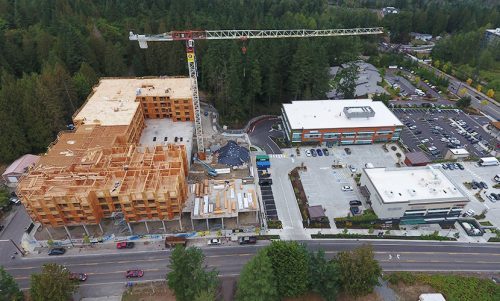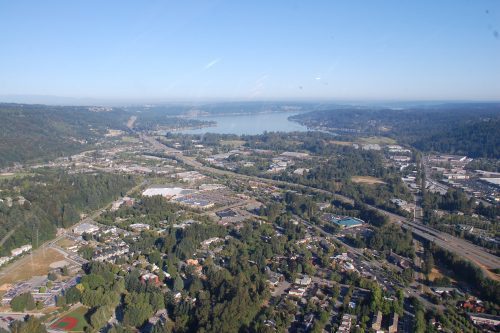
New multifamily construction in Sammamish. Courtesy Sky Sammamish.
The Puget Sound region’s extreme growth hasn’t gone over well with some residents. (To put it mildly.) That backlash has caused some frustrating policy snags, like the lawsuit that has placed Seattle’s MHA upzones on hold.
But construction in Seattle continued on plenty of multifamily projects. That hasn’t always been the case in the rest of King County. In recent years, several suburban cities, including Issaquah, Sammamish, and Federal Way, halted construction on new projects by enacting construction moratoria.
Under the Growth Management Act, a city can pause work on any or all kinds of new projects by enacting a construction moratorium. The power is broad, but not unlimited. A city has to cite specific detrimental impacts caused by new construction, and use the period of the moratorium to enact code changes that address the problem. A moratorium only lasts six months at a time, but can be renewed indefinitely. Issaquah, for example, renewed its moratorium three times before letting it expire earlier this year.
You might think that those laws are the product of NIMBYism. In some cases, that’s true. But the reality is more complicated.
Federal Way blocks dense, multifamily housing
Federal Way’s development moratorium was adopted near the end of 2016 as a response to a citywide backlash against multifamily housing construction in the center of the city, and a proposed redevelopment of part of the old Weyerhaeuser campus.
Federal Way’s moratorium came after a series of ugly public meetings. In the meetings, some residents blamed new, multifamily development in the center of the city for a series of shootings.
“This moratorium came after we had a series of shootings and killings in the city, and it seemed at the time that people tended to equate multifamily housing with that. That really bothered me a lot,” said Federal Way City Councilmember Dini Duclos at the time.
The moratorium was ostensibly enacted to allow the school district to catch up with growth, but a defensive qualifier in the moratorium ordinance stated that it was “not a reference to any recent crimes or criminal activity.”
Predictably, the code changes enacted by the city council in 2017 are a NIMBY wishlist. According to Federal Way Community Development Director Brian Davis, the code changes included:
- “Added language to reduce building massing”
- Increased parking requirements to one spot per bedroom, instead of 1.7 spots per unit, in neighborhoods outside the center city
- Limited building heights and increased setbacks near single family zones
According to Davis, “the intentions behind the adopted code amendments were to …improve the safety of residents, and to increase compatibility between new stacked non-single residential development and existing neighborhoods.”
Davis says that, since the moratorium ended in May 2017, only one major multifamily project, a 200 unit affordable senior apartment complex, has applied for a permit.
Sammamish mixes new density with bigger roads
In Sammamish, the picture is more complicated. The city isn’t exactly opposed to density, but it’s not taking proactive steps in that direction.
According to Sammamish Mayor Christine Malchow, residents are excited about the new amenities in the new, relatively dense town center. Some longtime residents have also expressed a desire for condos and apartments, so that they can downsize as they get older.
“If you were a long time resident, a lot of those people are leaving,” says Malchow. “That’s in part due to the housing mix. If you wanted to downsize from a four bedroom home to a condo—those aren’t here in Sammamish. The town center is needed from that perspective, to give affordability and a better housing mix.”
However, the town is still betting on driving and single family housing. The city’s politics are dominated by a fight over traffic and road capacity. The city council enacted the moratorium in order to recalculate the formula the city’s department of transportation uses to measure traffic congestion.
The new rules, which the city council enacted by popular demand, will require new construction to come online with expanded road capacity. In the past, new projects could instead build transit, pedestrian, or bicycle infrastructure.
Issaquah pauses to mandate an urban village
The moratorium that Issaquah enacted in 2016 was much more limited than those in Federal Way or Sammamish. In fact, the goal behind the moratorium was to encourage the development of mixed-use, transit-oriented, walkable neighborhoods in the center of the city. Nor was it a total freeze on building.
“It didn’t stop everything, even in the areas that were covered by the moratorium,” says Issaquah Mayor Mary Lou Pauly. “It was targeted at a certain scale of building product.”

Downtown Issaquah from the air. Courtesy City of Issaquah.
The 2012 Central Issaquah Plan is designed to contain sprawl through transit-oriented development, and limit car trips by developing the city as a job center. According to Pauly, the moratorium had to be put into place in order to meet those goals.
“We did not hear back from the community or businesses that we needed to revise what we had in the plan,” says Pauly. “We heard from the community and developers that we weren’t getting built product that matched the vision. We wanted to center development around I-90 and future light rail, with a connection to transit, the right aesthetic, a mix of jobs. We didn’t get that in 11 out of 12 projects that first came in.”
So the council developed the moratorium to tighten design and permitting standards. According to Pauly, who worked as a civil engineer for the Issaquah Development Commission before running for office, the code was loose to allow for creative design. But developers didn’t necessarily understand that.
“I had one developer come in and say, ‘You didn’t require me to have affordable units or main floor retail, so I didn’t. If you want that stuff, you have to require it.’”
Oddly enough, Issaquah decided to pause density in the short term, in order to make it the rule in the future. The last thing the city wants, according to Pauly, is to go the route of Federal Way.
“If cities are taking actions that shake the development community’s confidence, we can have unintended consequences,” Pauly says. “We can create a chill, or be seen as a partner who’s hard to work with. We don’t want that.”
![]()
![]()


